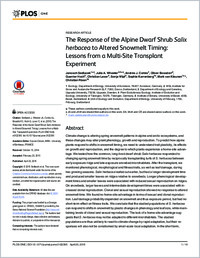The response of the alpine dwarf shrub Salix herbacea to altered snowmelt timing: lessons from a multi-site transplant experiment
- Sedlacek, Janosch Ecology, Department of Biology, University of Konstanz, Germany
- Wheeler, Julia A. WSL Institute for Snow and Avalanche Research, Davos, Switzerland - Institute of Botany, University of Basel, Switzerland
- Cortés, Andrés J. Department of Ecology and Genetics, Uppsala University, Sweden
- Bossdorf, Oliver Plant Evolutionary Ecology, Institute of Evolution and Ecology, University of Tübingen, Germany
- Hoch, Guenter Institute of Botany, University of Basel, Switzerland
- Lexer, Christian Unit of Ecology and Evolution, Department of Biology, University of Fribourg, Switzerland
- Wipf, Sonja WSL Institute for Snow and Avalanche Research, Davos, Switzerland
- Karrenberg, Sophie Department of Ecology and Genetics, Uppsala University, Sweden
- Kleunen, Mark van Ecology, Department of Biology, University of Konstanz, Germany
- Rixen, Christian WSL Institute for Snow and Avalanche Research, Davos, Switzerland
-
20.04.2015
Published in:
- PLoS ONE. - 2015, vol. 10, no. 4, p. e0122395
English
Climate change is altering spring snowmelt patterns in alpine and arctic ecosystems, and these changes may alter plant phenology, growth and reproduction. To predict how alpine plants respond to shifts in snowmelt timing, we need to understand trait plasticity, its effects on growth and reproduction, and the degree to which plants experience a home-site advantage. We tested how the common, long-lived dwarf shrub Salix herbacea responded to changing spring snowmelt time by reciprocally transplanting turfs of S. herbacea between early-exposure ridge and late-exposure snowbed microhabitats. After the transplant, we monitored phenological, morphological and fitness traits, as well as leaf damage, during two growing seasons. Salix herbacea leafed out earlier, but had a longer development time and produced smaller leaves on ridges relative to snowbeds. Longer phenological development times and smaller leaves were associated with reduced sexual reproduction on ridges. On snowbeds, larger leaves and intermediate development times were associated with increased clonal reproduction. Clonal and sexual reproduction showed no response to altered snowmelt time. We found no home-site advantage in terms of sexual and clonal reproduction. Leaf damage probability depended on snowmelt and thus exposure period, but had no short-term effect on fitness traits. We conclude that the studied populations of S. herbacea can respond to shifts in snowmelt by plastic changes in phenology and leaf size, while maintaining levels of clonal and sexual reproduction. The lack of a home-site advantage suggests that S. herbacea may not be adapted to different microhabitats. The studied populations are thus unlikely to react to climate change by rapid adaptation, but their responses will also not be constrained by small-scale local adaptation. In the short term, snowbed plants may persist due to high stem densities. However, in the long term, reduction in leaf size and flowering, a longer phenological development time and increased exposure to damage may decrease overall performance of S. herbacea under earlier snowmelt.
- Faculty
- Faculté des sciences et de médecine
- Department
- Département de Biologie
- Language
-
- English
- Classification
- Biological sciences
- License
- License undefined
- Identifiers
-
- RERO DOC 255635
- DOI 10.1371/journal.pone.0122395
- Persistent URL
- https://folia.unifr.ch/unifr/documents/304400
Statistics
Document views: 66
File downloads:
- lex_rad.pdf: 139
